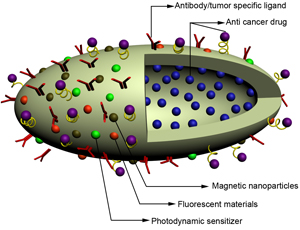Oct 29 2013
University of Cincinnati researchers have developed a unique nanostructure that can, because of its dual-surface structure, serve as an improved “all-in-one tool” against cancer.

Date: 10/28/2013 11:00:00 AM
By: M.B. Reilly
Phone: (513) 556-1824
Photos By: Provided by Donglu Shi
UC ingot A unique nanostructure developed by a team of international researchers, including those at the University of Cincinnati, promises improved all-in-one detection, diagnoses and drug-delivery treatment of cancer cells.
The first-of-its-kind nanostructure is unusual because it can carry a variety of cancer-fighting materials on its double-sided (Janus) surface and within its porous interior. Because of its unique structure, the nano carrier can do all of the following:
- Transport cancer-specific detection nanoparticles and biomarkers to a site within the body, e.g., the breast or the prostate. This promises earlier diagnosis than is possible with today’s tools.
- Attach fluorescent marker materials to illuminate specific cancer cells, so that they are easier to locate and find for treatment, whether drug delivery or surgery.
- Deliver anti-cancer drugs for pinpoint targeted treatment of cancer cells, which should result in few drug side effects. Currently, a cancer treatment like chemotherapy affects not only cancer cells but healthy cells as well, leading to serious and often debilitating side effects.
This research, titled “Dual Surface Functionalized Janus Nanocomposites of Polystyrene//Fe304@Si02 for Simultaneous Tumor Cell Targeting and pH-Triggered Drug Release,” will be presented as an invited talk on Oct. 30, 2013, at the annual Materials Science & Technology Conference in Montreal, Canada. Researchers are Feng Wang, a former UC doctoral student and now a postdoc at the University of Houston; Donglu Shi, professor of materials science and engineering at UC’s College of Engineering and Applied Science (CEAS); Yilong Wang of Tongji University, Shanghai, China; Giovanni Pauletti, UC associate professor of pharmacy; Juntao Wang of Tongji University, China; Jiaming Zhang of Stanford University; and Rodney Ewing of Stanford University.
This recently developed Janus nanostructure is unusual in that, normally, these super-small structures (that are much smaller than a single cell) have limited surface. This makes is difficult to carry multiple components, e.g., both cancer detection and drug-delivery materials. The Janus nanocomponent, on the other hand, has functionally and chemically distinct surfaces to allow it to carry multiple components in a single assembly and function in an intelligent manner.
“In this effort, we’re using existing basic nano systems, such as carbon nanotubes, graphene, iron oxides, silica, quantum dots and polymeric nano materials in order to create an all-in-one, multidimensional and stable nano carrier that will provide imaging, cell targeting, drug storage and intelligent, controlled drug release,” said UC’s Shi, adding that the nano carrier’s promise is currently greatest for cancers that are close to the body’s surface, such as breast and prostate cancer.
If such nano technology can someday become the norm for cancer detection, it promises earlier, faster and more accurate diagnosis at lower cost than today’s technology. (Currently, the most common methods used in cancer diagnosis are magnetic resonance imaging or MRI; Positron Emission Tomography or PET; and Computed Tomography or CT imaging, however, they are costly and time consuming to use.)
In addition, when it comes to drug delivery, nano technology like this Janus structure, would better control the drug dose, since that dose would be targeted to cancer cells. In this way, anticancer drugs could be used much more efficiently, which would, in turn, lower the total amount of drug administered.
This work was provided support via grants from the National Science Foundation (No. IOS-0843424); National Natural Science Foundation of China (No. 51003077, No. 51173135, and No. 51073121); Shanghai Nano-program (No. 11nm0506011); and the Fundamental Research Funds for the Central Universities.